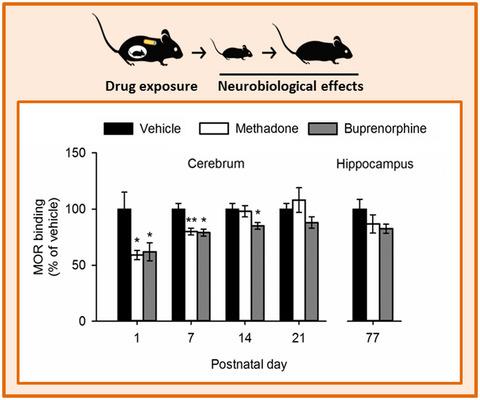当前位置:
X-MOL 学术
›
Int. J. Dev. Neurosci.
›
论文详情
Our official English website, www.x-mol.net, welcomes your
feedback! (Note: you will need to create a separate account there.)
Prenatal exposure to methadone or buprenorphine alters µ-opioid receptor binding and downstream signaling in the rat brain
International Journal of Developmental Neuroscience ( IF 1.7 ) Pub Date : 2020-06-29 , DOI: 10.1002/jdn.10043 Mette Kongstorp 1, 2 , Inger Lise Bogen 1, 3 , Synne Steinsland 1 , Elisabeth Nerem 1 , Triske Woshyar Salih 1 , Tom Stiris 2, 4 , Jannike Mørch Andersen 1, 5
International Journal of Developmental Neuroscience ( IF 1.7 ) Pub Date : 2020-06-29 , DOI: 10.1002/jdn.10043 Mette Kongstorp 1, 2 , Inger Lise Bogen 1, 3 , Synne Steinsland 1 , Elisabeth Nerem 1 , Triske Woshyar Salih 1 , Tom Stiris 2, 4 , Jannike Mørch Andersen 1, 5
Affiliation

|
There is a growing concern related to the use of opioid maintenance treatment (OMT) during pregnancy. Studies in both humans and animals have reported reduced cognitive functioning in offspring prenatally exposed to methadone or buprenorphine; however, little is known about the neurobiological mechanisms underlying these impairments. To reveal possible neurobiological effects of such in utero exposure, we examined brain tissue from methadone- and buprenorphine-exposed rat offspring previously shown to display impaired learning and memory. We studied µ-opioid receptor (MOR) and N-methyl-D-aspartate receptor (NMDAR) binding in the rat offspring cerebrum during development and in the hippocampus at young adulthood. Moreover, we examined activation of the Ca2+ -calmodulin dependent protein kinase II (CaMKII) and the extracellular signal-regulated kinase (ERK), which are central in the downstream signaling of these receptors. The methadone- and buprenorphine-exposed rat pups displayed reduced MOR binding up to two weeks after birth, whereas the NMDAR binding was unaffected. Prenatal exposure to methadone or buprenorphine also resulted in decreased activation of CaMKII and/or ERK during development, while young adult offspring displayed increased hippocampal ERK activation. In conclusion, our findings suggest that prenatal exposure to exogenous opioids such as methadone or buprenorphine may disturb the endogenous opioid system during development, with long-term effects on proteins important for cognitive functioning.
中文翻译:

产前接触美沙酮或丁丙诺啡会改变大鼠大脑中的 µ-阿片受体结合和下游信号传导
人们越来越关注怀孕期间使用阿片类药物维持治疗 (OMT)。对人类和动物的研究表明,产前接触美沙酮或丁丙诺啡的后代认知功能会下降;然而,人们对这些损伤背后的神经生物学机制知之甚少。为了揭示这种药物在子宫内暴露可能产生的神经生物学影响,我们检查了暴露于美沙酮和丁丙诺啡的大鼠后代的脑组织,之前显示出学习和记忆受损。我们研究了发育过程中大鼠后代大脑中的 µ-阿片受体 (MOR) 和 N-甲基-D-天冬氨酸受体 (NMDAR) 以及成年早期海马中的结合。此外,我们还检测了 Ca2+ 钙调蛋白依赖性蛋白激酶 II (CaMKII) 和细胞外信号调节激酶 (ERK) 的激活,它们是这些受体下游信号传导的核心。暴露于美沙酮和丁丙诺啡的幼鼠在出生后两周内表现出 MOR 结合减少,而 NMDAR 结合不受影响。产前接触美沙酮或丁丙诺啡也会导致发育过程中 CaMKII 和/或 ERK 激活减少,而年轻成年后代则表现出海马 ERK 激活增加。总之,我们的研究结果表明,产前接触美沙酮或丁丙诺啡等外源性阿片类药物可能会在发育过程中干扰内源性阿片类药物系统,对认知功能重要的蛋白质产生长期影响。
更新日期:2020-06-29
中文翻译:

产前接触美沙酮或丁丙诺啡会改变大鼠大脑中的 µ-阿片受体结合和下游信号传导
人们越来越关注怀孕期间使用阿片类药物维持治疗 (OMT)。对人类和动物的研究表明,产前接触美沙酮或丁丙诺啡的后代认知功能会下降;然而,人们对这些损伤背后的神经生物学机制知之甚少。为了揭示这种药物在子宫内暴露可能产生的神经生物学影响,我们检查了暴露于美沙酮和丁丙诺啡的大鼠后代的脑组织,之前显示出学习和记忆受损。我们研究了发育过程中大鼠后代大脑中的 µ-阿片受体 (MOR) 和 N-甲基-D-天冬氨酸受体 (NMDAR) 以及成年早期海马中的结合。此外,我们还检测了 Ca2+ 钙调蛋白依赖性蛋白激酶 II (CaMKII) 和细胞外信号调节激酶 (ERK) 的激活,它们是这些受体下游信号传导的核心。暴露于美沙酮和丁丙诺啡的幼鼠在出生后两周内表现出 MOR 结合减少,而 NMDAR 结合不受影响。产前接触美沙酮或丁丙诺啡也会导致发育过程中 CaMKII 和/或 ERK 激活减少,而年轻成年后代则表现出海马 ERK 激活增加。总之,我们的研究结果表明,产前接触美沙酮或丁丙诺啡等外源性阿片类药物可能会在发育过程中干扰内源性阿片类药物系统,对认知功能重要的蛋白质产生长期影响。











































 京公网安备 11010802027423号
京公网安备 11010802027423号